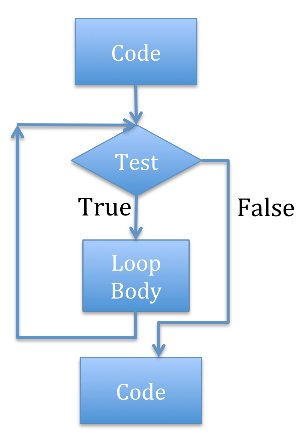Iterations in programs allow us to perform repetitive tasks in a loop. Let’s have look at the following flow diagram.
Observing the flow diagram:
- A test (expression that evaluates to
TrueorFalse) - If the test is
True, then execute the loop body once and go back to re-evaluate the test - Repeat until test evaluates to
False, after which code following iteration statement is executed
Table of Contents
- A simple example of iteration using
whileconstruct in Python: - A simple example of iteration using
forconstruct in Python: - What to use & When?
A simple example of iteration using while construct in Python:
x = 0
result = 0
upper_limit = 10
while (x <= upper_limit): # Looping condition
result = result + x
x = x+1 # Incrementing x by 1
print 'Sum of first ' + str(upper_limit) + ' numbers is ' + str(result)On execution, the above program prints:
Sum of first 10 numbers is 55Analysis of the above code:
- First, we declare 3 integer variables,
x,resultandupper_limit - In the
whileloop we have a condition, and the code block inside the loop gets executed as long as the condition isTrue - Inside the code block we add
xtoresultand incrementxby 1- We are actually trying to find the sum of first 10 numbers
- As soon as
xbecomes 11, the condition insidewhileloop evaluated toFalseand hence the loop breaks - Lastly we print out the sum of first 10 numbers
In programming, a code performing similar task can be written in multiple ways.
For instance, we can write the above code using for construct as well.
A simple example of iteration using for construct in Python:
result = 0
for x in range(1,11): # range() function explained below
result = result + x
print 'Sum of first 10 numbers is ' + str(result)Analysis of the above code:
- Let’s first see how
range()works
>>> range(10) #returns a list that contains numbers from 0 to (10-1)
[0, 1, 2, 3, 4, 5, 6, 7, 8, 9] # This is a 'list' of integers
>>> range(1, 10) # Here we force range() to start from 1 and end before 10
[1, 2, 3, 4, 5, 6, 7, 8, 9]
>>> range(1, 11) # This is what we used in the for loop above
[1, 2, 3, 4, 5, 6, 7, 8, 9, 10]
>>> range(1, 11, 2) # Third argument 2 says that it will jump 2 steps. 2 is called 'step argument'
[1, 3, 5, 7, 9]
>>> range(1, 11, 3) # 3 makes it jump 3 steps at a time
[1, 4, 7, 10]- Now that we know what range does,
forsimple iterates over each value in the the list returned by range and assigns it tox - Inside the
forloop we addxtoresult - Finally, we print out the result
See? How easy it was to perform the same task in a different way.
What to use & When?
- Use
whilewhen you don’t know the number of times the loop should repeat. It’s only used when you know the condition when loop should break. - Use
forwhen you know the fixed number of times the loop should repeat.
Next we will apply the knowledge gained so far to solve an interesting problem. How to find square root of any number?
Note: This is a part of what I learned in an online Open Course Ware offered by MIT on edX. Its for my personal reference & also for those who would like to revisit the course.

